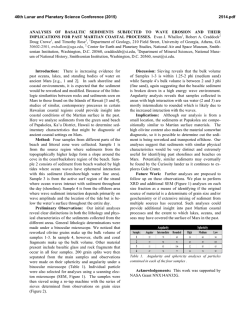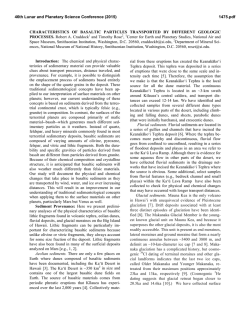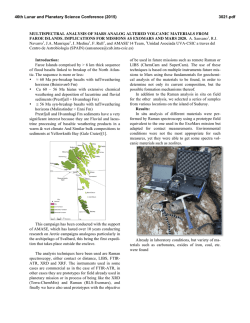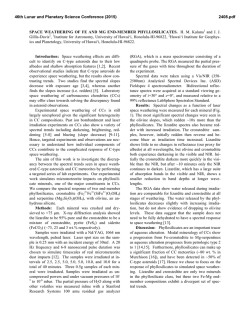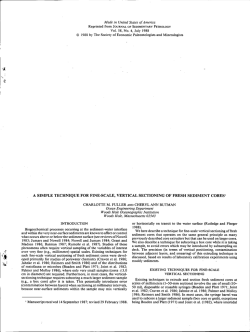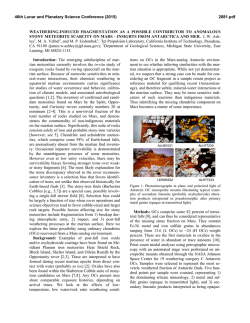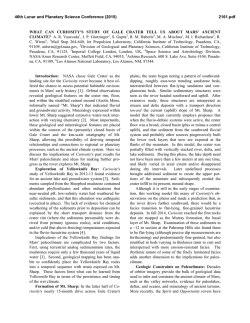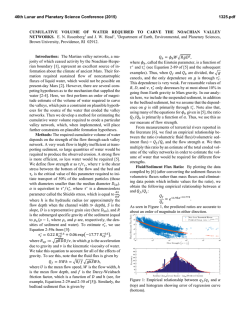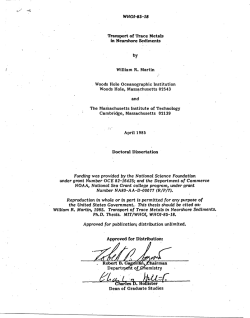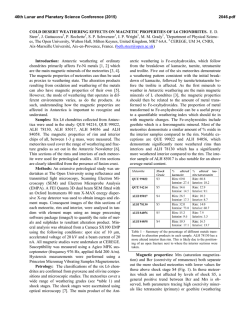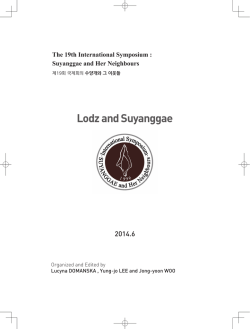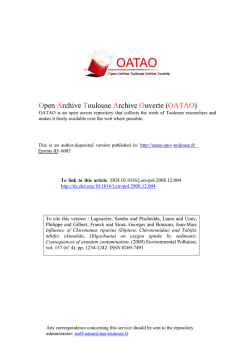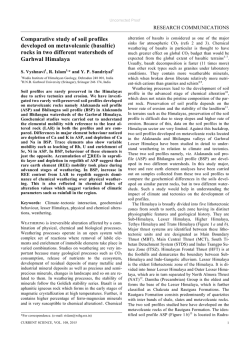
CHEMICAL WEATHERING IN CONTRASTING CLIMATES
46th Lunar and Planetary Science Conference (2015) 2131.pdf CHEMICAL WEATHERING IN CONTRASTING CLIMATES: PRELIMINARY RESULTS AND IMPLICATIONS FOR INTERPRETING PALEOCLIMATE ON MARS. Y. J. Joo1, R. Funderburg1, G.S. Soreghan1, and M.E. Elwood Madden1, 1School of Geology and Geophysics, University of Oklahoma, Norman, OK, USA, ([email protected]). Introduction: Contrasting mineralogy and geomorphic features in ancient and younger rocks on Mars suggest that the planet has likely experienced varying climate conditions throughout its history. Clay mineral deposits and fluvial drainage networks suggest prevalent aqueous alteration from surface water occurred early in its history, which then transitioned to an acidic wet environment where sulfate minerals were deposited, and finally conditions became cold & dry [1]. Climate conditions, particularly temperature and water availability can affect weathering rates of minerals and the type of secondary minerals produced [1,2]. Typically it is assumed that colder conditions have slower chemical weathering rates than hot climates, but previous work has shown that sediments from cold, arid polar regions on Earth can be more reactive than sediments from a hot, arid desert [3]. In these cases, differing modes of physical weathering may result in varying sediment reactivity, thus providing an additional variable affecting chemical weathering rates. This study evaluates the chemical reactivity of terrestrial sediments derived from similar bedrock sources under differing climate conditions to better understand the effects of temperature, precipitation, and physical weathering mechanisms on chemical weathering rates and products. These results can be applied to mineral assemblages observed in sedimentary deposits on Mars to better understand Mar’s climate history. Methods: Alluvial sediment samples were collected from drainage basins of similar size, relief, and bedrock lithology in Puerto Rico (hot and wet); Anza Borrego, CA (hot and dry); Jostedalsbreen, Norway (cold and wet) and Denton Glacier, Antarctica (cold and dry) (see Table 1 for climate details). Sediments were wet sieved and treated to remove organics and carbonates. The mud fraction was freeze dried. The surface areas of each size fraction were determined using the BET method. Batch reactor dissolution experiments were used to compare the chemical reactivity of the mud (<62 µm) and sand fractions (125 – 2000 µm), independent of the sediment surface area by reacting samples of equal BET measured surface area of the different size fractions. Sediments were dissolved in pH 8-9 Tris buffered and constantly agitated on a shaker table for several weeks. The resulting aqueous solutions were removed and filtered at predetermined time intervals, and then refrigerated prior to ICP-OES analysis. Results & Discussion: Sediment from Denton Glacier, in the McMurdo Dry Valleys (MDV) of Antarctica, was more chemically reactive than sediment collected from a hot, dry desert Anza Borrego Desert in Southern California. The Denton glacier sediment was an order of magnitude or more reactive for Si and Al, which indicates that more primary mineral weathering is occurring in the sediment (Figure 1). Despite very dry conditions in both systems, the Antarctic sediments may be more chemically reactive due to differing modes of physical weathering. Physical weathering via freeze-thaw cycling, eolian abrasion, and possible glacial grinding (polar glaciers are not expected to produce significant rock flour, but some basal grinding may occur [4]) may produce a greater concentration of chemically reactive sites on mineral surfaces in the Denton Glacier samples. While primary minerals predominate within the fine fraction in Denton Glacier sediments, significant amounts of clay minerals were observed in Anza Borrego Desert sediments, suggesting hydrolysis of feldspars is occurring, despite very low levels of precipitation. This may reflect the occurrence of in situ chemical weathering within bedrock and regolith in Anza Borrego prior to sediment transport during brief periods of precipitation. Analyses of samples collected in Puerto Rico and Norway are ongoing. Initial results indicate sediments collected in Puerto Rico contain the highest volume of clay minerals, suggesting higher temperatures result in significantly more clay formation. Sediments from Norway contain abundant silt-sized particles, likely produced through glacial grinding in a wet-based glacial environment. Stream water chemistry: Solute concentrations determined from water samples collected contemporaneously with sediment samples in Antarctica, Norway, and Puerto Rico (no flowing water was observed in Anza Borrego during the field period) compliment these experimental results. Stream water chemistry suggests significant primary mineral dissolution is occurring in the Antarctic Dry Valleys streams, resulting in similar solute concentrations as those observed in the tropical streams sampled in Puerto Rico. However, Norwegian glacial streams had much lower solute concentrations compared to both Antarctic and Puerto Rican streams. Despite lower solute con- 46th Lunar and Planetary Science Conference (2015) centrations, solute fluxes observed in Norway may be similar to those observed in Antarctica, due to much larger volumes of water flowing in the Norwegian streams, leading to dilution of solutes. However, downstream flow volumes in Puerto Rico were similar to stream volumes observed in Norway, resulting in significantly larger solute fluxes in the warm, wet environment compared to the cold, wet glacial system. Future work will compare the chemical reactivity of sediments from Norway, produced primarily through glacial grinding below a large wet-based glacier to drift and stream sediments collected in the Antarctic MDV, associated primarily with cold-based polar glaciers, to determine the effects of differing glacial processes on sediment texture and reactivity. Implications for Mars: The MDV are analogous to mid-latitude climate conditions on Mars, with widespread permafrost, but surface temperatures occasionally reaching ice melting conditions. Indeed, water seeps [5], polygonal terrains [6-8], and chemical weathering within drift deposits [9, 10] in the MDV have been proposed as terrestrial analogs for similar features observed on Mars. Therefore, chemical weathering processes observed in the MDV may inform our understanding of limited aqueous activity which may have occurred on Mars during the Amazonian. Results from this study indicate that, while chemical weathering in the Dry Valleys is spatially and temporally limited by the availability of liquid water, ephemeral water flow can produce significant weathering fluxes, transporting cations away from fresh mineral surfaces and concentrating solutes within closed-basin lakes. Only small volumes of clay minerals were observed in the fine-grained sediments, and those present may be recycled from local sources via eolian transport and subsequent concentration on and re-release from glacial surfaces [11]. Solutes observed in the Norwegian streams suggest that significant dissolution of primary minerals is occurring within this glacial environment as well. While solute concentrations were lower than those observed in Antarctica, stream volume was significantly higher, leading to solute fluxes similar to those observed in the Dry Valleys. This suggests that despite cold temperatures, significant chemical weathering can occur in glacial environments when liquid water is present. However, wholesale dissolution of primary minerals may be more prevalent than incongruent weathering of silicates to form clays, resulting in significant solute fluxes. While some clays were observed in sediments from the Anza Borrego Desert, Norwegian sediments, and Antarctic drift samples, clay minerals were most abundant in samples collected from Puerto Rico, reinforcing 2131.pdf that abundant water and warmer temperatures are required to form significant volumes of clay under terrestrial conditions. References: [1] Bibring et al. (2006) Science, 312, 400-403. [2] Ehlmann et al. (2013) Space Sci. Review, 174, 329-364. [3] Funderburg et al (2014) AGU Fall Meeting 2014, Abstract # EP23A-3587. [4] Atkins et l. (2002) Geology 30, 659-662. [5] Harris et al. (2007) Geol. Soc. Am. Bul. 119, 548-555. [6]Levy et al. (2009) GRL, 36, L21203. [7] Levy et al. (2010) Icarus 206, 229-252. [8] Heldman et al. (2013) Planet. & Space Sci. 85, 53-58. [9] Salvatore et al. (2013) GCA 115, 137-161. [10] Bishop et al. (2013) Icarus 224, 309-325. [11] Marra et al. (2013) Geomorph. 206, 483-491. Table 1. Climate conditions observed at each field site (annual means). Location Temperature Precipitation (C) (mm/yr) Indian Gorge, Anza 23 150 Borrego Desert, CA Rio Guayanes River, 22 4200 Puerto Rico Jostedalsbreen, 4.5 1769 Norway Denton Glacier, -20 17.6 MDV, Antarctica Figure 1. Graph of concentration (mol m-2 kg-1) vs time. Mud (closed shape) and sand (open shape) sized sediment from Denton Glacier, shown in blue, is more reactive for Si (circles) and Al (triangles) than sediments from Anza Borrego, CA (orange).
© Copyright 2026
